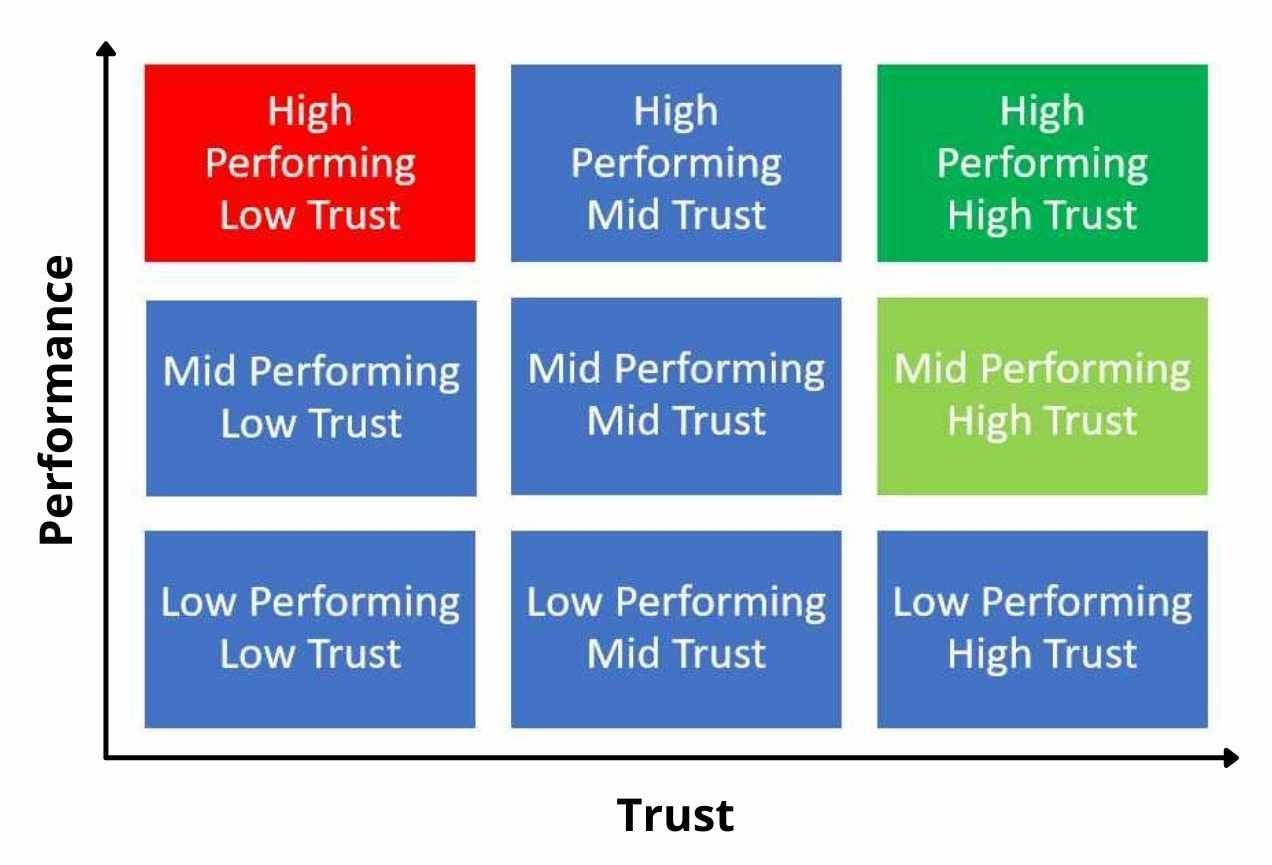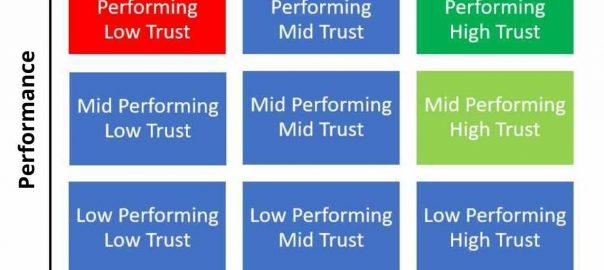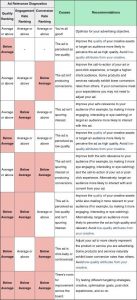
Many businesses struggle with employee issues. Sometimes you can’t count on an employee to make their shift, leaving you in a labor bind at the last minute, or trust an employee to complete a job on time or to your standards. Other times, you have employees that, no matter how hard you try to teach them something, just can’t seem to get it consistently. As a business owner, you need to be able to understand which employees are team players and trustworthy and are reasonably good at their jobs. Being just a good team player or just a high performer are not desirable traits to have working for you. The proper combination of trust and performance is vital to your success. The Navy SEALs had a similar issue, so they devised a way to measure it using a performance vs trust matrix.

SEAL Trident
As we all know, the Navy SEALs are an elite fighting unit. Some members have massive skills on the battlefield and are fierce warriors but may take ill-advised risks, subjecting other teammates to harm, making them less trusted by their peers. Other members may not be the best marksmen or warriors but have intense loyalty to their comrades and are real team players willing to risk harm to themselves to assist others. SEAL team commanders knew that the best members could not just rank as high performers in battle or just be great team players. To have an elite squad, members had to have a combination of both performance and trust factors in the right proportions, so they rank members of the team using the performance vs trust matrix.
Clearly, members that ranked low in performance and trust were team members nobody wanted on their squad. The best members were ones that ranked high in both performance and trust, unfortunately, that type of SEAL team member was not that common. The Navy then tried to determine whether it was being a great performer or a trusted team player that was most valuable. What the Navy SEALs discovered was that members that ranked high in performance but low in trust tended to be toxic team members and poor leaders. Likewise, a SEAL team member who ranked low on the performance scale was equally undesirable. When a high-performer with high trust factors was not available, commanders found team members with only average performance but high trust as a very desirable combination, especially over the high-performance but low trust member. Once a threshold of competency was achieved, being trustworthy proved to be more valuable than proficiency.
So why is this important for businesses? The main reason is that businesses place too much weight on job performance and rarely ever even consider trust. Most companies have lots of metrics to measure an employee’s performance and skills but no real metrics to measure someone’s trustworthiness or intrinsic motivation. Many businesses forget that their biggest asset is their people and their ability to work together toward a common goal. Reaching this common goal requires trust among team members. Let’s face it, it is far easier to work with someone you can trust than with someone you don’t. Given a choice, would you choose to work with someone who’s good at what they do but does not show respect and honesty to others, or with someone that has basic competencies but is willing to do whatever it takes and go out of their way to help others?
Most businesses reward the employee that is a great performer. Unfortunately, these same high performers are often the ones that their peers hate in the organization. The character-archetype for the high performer low trust employee that comes to mind is Ebenezer Scrooge. Based on a measure of wealth, Ebenezer is a high performer, but everyone hated him because he was self-centered and by no means a team player.
Often these high-performing employees are so driven to be the top performers in an organization that their actions consciously and unconsciously sabotage other employees. They tend to be condescending toward teammates often to the point of abuse. They frequently withhold important information from others if it is to their advantage. However, managers consistently reward these individuals because they always hit their numbers and get their projects completed on time. The downside is that these employees are so toxic to the culture that they drive good employees, that are team players, to leave the organization. While individually they perform well, they taint the company’s culture in a way that drives down overall company productivity and leads to high turnover.
High trust but medium performance employees are the employees that will always have your back. The character-archetype for the high trust and medium performance employee that comes to mind is Katniss Everdeen in the Hunger Games. Based on a measure of sacrifice before self and being a team player, Katniss is a high trust person that helps others and as a result, wins the game. High trust medium performance employees are intrinsically motivated and will bend over backward to help team members or for the good of the company. While they may not be top performers, they are willing to come in on their days off to help a teammate to complete a project on time. They take courses on their own time to improve their skills. And they take ownership of problems or errors and never blame others. These are the employees that a business can really count on. However, since trust and loyalty are factors that are harder to measure, they often are overlooked by the company.
Case Study
I recently read Simon Sinek’s book The Infinite Game where he shared how the Navy SEALs chose who to send on missions. One of my clients shared a real problem they were having with their employees. They said that they were experiencing a high level of turnover and as a result, they were somewhat reluctant to take any kind of disciplinary action, fearing that these employees would leave if reprimanded, making their problem even worse. As an outsider, I could see that one of the reasons they were perpetually short-staffed was because their high trust average performers were leaving while the toxic but high-performing employees were being rewarded. It was at that point that I recommended developing a performance vs trust matrix to create a non-toxic environment.
To construct a performance vs trust matrix similar to the one used by the Navy SEALs, you construct a matrix with trust along the bottom or horizontal axis and performance along the vertical axis.

Performance represents the skills that the employee has on the job. These are what you typically go over during an employee’s performance review. Trust by comparison is largely defined by their character, what employees do outside of work, and how they are viewed by their peers.
I asked the business to speak to their employees and team leads and ask them to rank the most trustworthy employees with a history of bending over backward to help others. Then I asked that they rank employees based strictly on their job proficiency. Armed with this information, I asked them to write everyone’s name on a sticky pad and place them on a performance vs trust matrix. It soon became visually obvious who were the toxic employees and who they might want to coach or sever ties with and who the business should make every effort to keep on the team.
A company that operates without the trust dimension will struggle to succeed or grow. It’s easy to find highly skilled and proficient employees but who are not very trustworthy. Having them working in your business without correcting and guiding them creates a toxic work environment for the rest of your employees. We all know that companies need employees and project teams with skills, talents, and knowledge. However, to really succeed you need to have a culture where members trust each other. That is where the performance vs trust matrix comes in.
Constructing a performance vs trust matrix is an eye-opener for business owners. The goal is not to forego performance over trust but instead to show that you need to place equal importance on building trust between employees and team members as on performance. While most businesses are good at measuring performance, most do not attempt to take into account an employee’s trustworthiness.
Top-performing employees are often the ones that get promoted but businesses are better served by promoting and rewarding employees that everyone trusts. It’s hard for a business to be successful if your employees don’t trust the people they work for or with. Employees that are not trustworthy or team players, should either be coached or cut loose so as not to create a toxic work environment.
You may have the best cook in your kitchen that can cook anything or the best salesperson who can sell anything but if these employees make life difficult for other employees to perform their jobs or don’t help groom peers achieve the same level of performance, they are contributing to a toxic environment that promotes performance over teamwork and trust. Whatever success you might be experiencing currently will not be sustainable if you don’t correct the situation. This is why the performance vs trust matrix is a powerful tool for employee-based businesses.
How can you use the performance vs trust matrix to discover which employees to reward and which to coach or cut loose?
Business & Finance Articles on Business 2 Community
(343)








